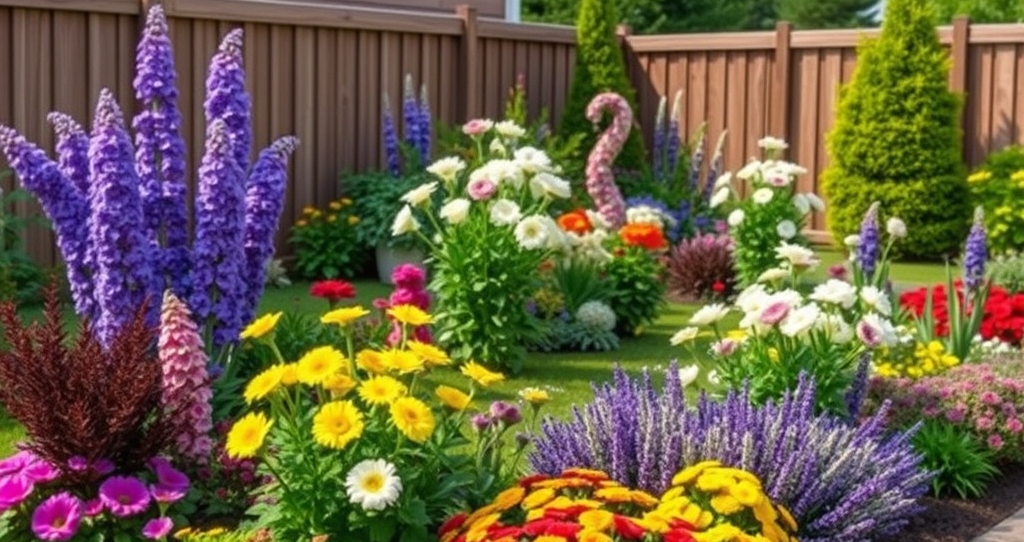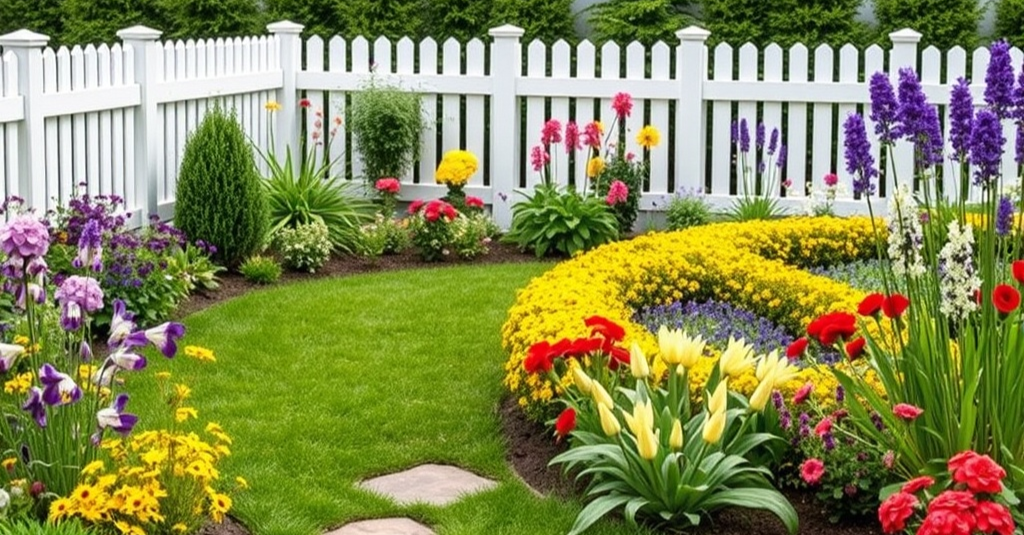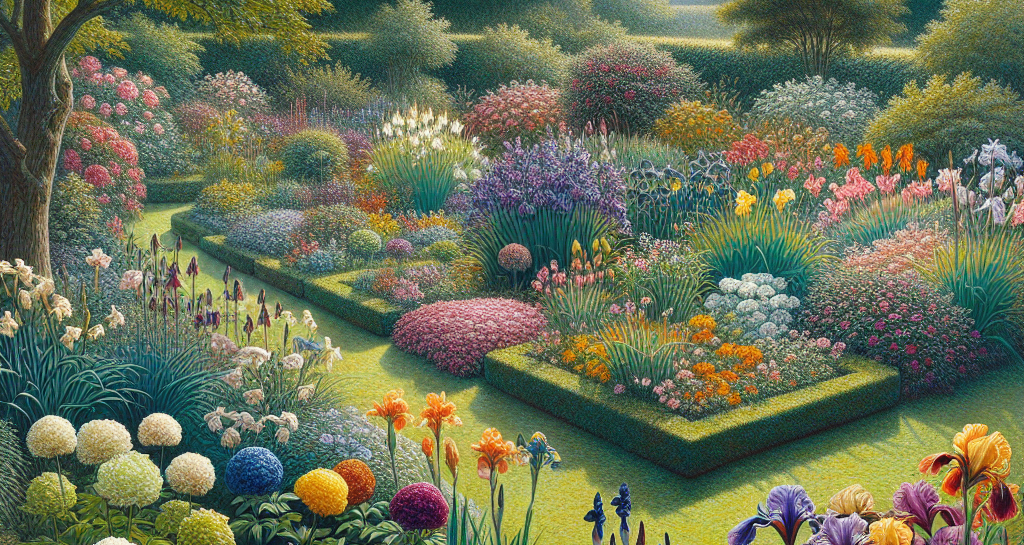Perennial gardens are a fantastic way to create a beautiful and lasting landscape in your yard. Unlike flowers that need to be replanted every year some types of flowers can keep growing year after year without replanting. Yearly perennials return year after year offering long-lasting color and beauty with minimal maintenance. This manual is designed to assist you in converting your garden. By Transfer Your Yard Layout Perennial Flower Garden Design Plans.
Introduction to Perennial Gardening
What Are Perennials?
Perennials are plants that live for more than two years. They are an excellent investment for garden enthusiasts as they grow back each year after dormancy providing consistent blooms and greenery.
Why Choose Perennials?
- Low Maintenance: Once established perennials are relatively easy to care for.
- Cost-Effective: You save money on replanting every season.
- Diversity: They come in various colors sizes and shapes allowing for a customizable design.
Key Elements of Perennial Flower Garden Design
Before you start planting it is essential to think about a few things that will affect how you set up your garden.
Assessing Your Yards Layout
The first step in creating a perennial garden is assessing the current layout of your yard. Ask yourself the following questions:
- What is the sun exposure? Different perennials thrive in full sun partial shade or full shade.
- What is the soil type? It is essential to know what kind of soil you have sandy clay or loamy so Choosing the suitable flora for your garden is essential.
- How is the drainage? Ensure your yard has proper drainage as waterlogged soil can harm plant roots.
| Yard Condition | Important Considerations |
|---|---|
| Sun Exposure | Choose sun-loving or shade-tolerant plants based on sun hours. |
| Soil Type | Amend soil as needed to ensure healthy growth. |
| Drainage | To avoid waterlogged soil make sure there is adequate drainage. |
Understanding Plant Height and Spread
Knowing how tall and wide your plants will grow is essential when designing your garden. Place taller plants toward the back of the garden (or the center if designing an island bed) and shorter plants near the front to ensure the visibility of all flowers.
| Plant Placement | Characteristics and Design Tips |
|---|---|
| Tall Plants | Plant at the back for layered effect. |
| Medium Plants | Place in the middle for balance. |
| Short Plants | Plant in the front for visibility. |
Color Schemes and Seasonality
Color is one of the most exciting aspects of garden design. Consider complementary or contrasting color schemes. Planning for blooms throughout the growing season would ensure you have something flowering from spring through fall.
| Season | Flower Types & Blooming Time |
|---|---|
| Spring | Tulips Daffodils Bleeding Heart |
| Summer | Coneflowers Black-Eyed Susans Daylilies |
| Fall | Asters Sedum Chrysanthemums |
Creating a Perennial Garden Design Plan
Once you have assessed your yard and considered plant characteristics it is time to start designing. This section outlines a step-by-step approach to help you create a perennial flower garden that matches your yard layout.
Sketch Your Yard
Please commence by creating a basic outline of your garden. Note areas of sunshade water sources and pathways. Consider existing structures such as trees fences or patios. This sketch will serve as a base for your design.
Choose Your Plants
Once your sketch is ready choose plants that fit your yard conditions. Here is an essential sun and shade perennials template to help guide you
| Perennials for Sun | Perennials for Shade |
|---|---|
| Lavender | Hosta |
| Black-Eyed Susan | Ferns |
| Coneflower | Astilbe |
Group Plants by Bloom Time
It is important to arrange plants so that something is always in bloom. Grouping plants with similar bloom times together ensures a continuous show of color throughout the growing season.
Best Practices for Planting Perennials
- Soil Preparation: Use compost or organic matter to enrich the soil and improve drainage.
- Spacing: Give plants enough space to grow and spread. Remember to ensure proper air circulation by avoiding crowded plants and disease.
- Watering: Water deeply after planting and mulch around the base to retain moisture.
Maintenance Tips for a Thriving Perennial Garden
Perennials are relatively low-maintenance but they still require some care to thrive year after year.
Pruning and Deadheading
When you remove old flowers from plants it helps them make new flowers. Produce more blooms. Prune plants annually to control growth and maintain shape.
| Task | Frequency | Benefit |
|---|---|---|
| Deadheading | Regularly | Promotes continued blooming. |
| Pruning | Annually | Keeps plants healthy and shapely. |
Fertilization
Use slow-release fertilizers in the spring to give plants a nutrient boost. Be careful not to use too much fertilizer because it can cause the plant to grow too tall and weak.
Dividing Perennials
Many plants that come back year after year can grow better if you split them into smaller parts every couple of years. Dividing plants promotes healthier growth and prevents overcrowding.
| Perennials to Divide | When to Divide |
|---|---|
| Daylilies | Every 3-5 years |
| Hostas | Every 3-4 years |
Design Inspiration for Perennial Gardens

Creating a garden that is both functional and beautiful requires some design inspiration. Here are a few ideas to help you plan a stunning perennial flower garden layout:
Cottage Garden Style
Cottage gardens are known for their relaxed informal style. Plants are often closely packed together creating a natural overflowing effect. Mix various plant heights and colors in this type of design for a whimsical romantic look.
Modern Minimalist Garden
If you prefer a more structured look consider a minimalist design with clean lines and fewer plant varieties. Choose a few standout perennials like ornamental grasses or lavender and plant them in neat symmetrical rows.
Wildlife Garden
Attract birds bees and butterflies by planting pollinator-friendly perennials. Incorporate plants like coneflowers milkweeds and black-eyed Susans. This garden not only looks beautiful but supports local wildlife.
Tools and Resources for Planning Your Perennial Garden
Garden Design Software
Before you start working on your garden think about using online tools and apps to make a digital plan of how you want it to look. These tools allow you to visualize plant placement and adjust the layout easily.
| Tool Name | Features |
|---|---|
| SmartDraw | Easy-to-use garden layout tool. |
| Garden Planner Online | Drag-and-drop design for garden layout. |
Books and Guides
If you prefer offline resources there are many gardening books available that focus on perennial garden design.
| Book Title | Author |
|---|---|
| The Well-Tended Perennial Garden | Tracy DiSabato-Aust |
| Perennial Combinations | C. Colston Burrell |
Common Mistakes to Avoid in Perennial Garden Design
Even seasoned gardeners can make mistakes when designing a garden. Here are a few common pitfalls to avoid:
Overcrowding Plants
While it may be tempting to plant everything close together for instant impact overcrowding leads to poor air circulation and unhealthy plants. Be patient and allow room for growth.
Ignoring Maintenance Needs
Some perennials require more maintenance than others. Ensure you choose plants that match the amount of time you can dedicate to gardening.
Forgetting Seasonality
It is essential to plan for year-round interest. Make sure your garden is not a one-season wonder by including plants that bloom at different times.
Conclusion: Enjoying Your Perennial Flower Garden
Transforming your yard layout into a stunning perennial flower garden takes time planning and effort. However the rewards are well worth it. A carefully designed perennial garden offers beauty year after year with minimal maintenance. The possibilities are endless whether you prefer a whimsical cottage garden or a sleek modern design. Take the time to plan plant and nurture your garden and it will provide enjoyment for years to come.
Perennial Garden Design: Adding Features for Functionality and Aesthetics

In addition to selecting plants you can add features that enhance your perennial functionality and aesthetics. These features help to frame the garden making it more visually appealing and serving practical purposes.
Pathways and Walkways
Pathways are not just for navigating your garden—they also break up the space and add structure to the design. Gravel brick or stepping stones can complement your garden style and guide visitors through the blooms.
- Gravel Pathways: Easy to install and maintain perfect for cottage-style gardens.
- Brick or Paver Walkways: Adds a classic structured feel to modern or formal garden designs.
- Natural Stone Steps: Great for gardens with elevation changes or for creating a rustic look.
Water Features
A small fountain birdbath or pond can introduce an element of tranquility and attract birds and wildlife to your garden. These features can be strategically placed at focal points to draw attention and create a calming atmosphere. Ally is placed at focal points to draw attention and create a calming atmosphere.
| Water Feature | Benefit |
|---|---|
| Birdbath | Attracts birds adds charm |
| Small Fountain | Provides soothing water sounds |
| Pond with Water Plants | Supports wildlife and pollinators |
Garden Borders and Edging
Consider installing borders or edging to keep your perennial garden neat and organized. This helps separate your plants from pathways or the lawn while adding a finished look to the design.
- Wooden Edging: This creates a natural rustic look ideal for informal gardens.
- Metal or Stone Edging: Perfect for creating clean straight lines in a more formal garden.
- Living Edging: Use low-growing perennials like lavender or thyme as living borders.
Sustainable and Eco-Friendly Garden Practices
Garden design is placing more emphasis on sustainability these days. Using eco-friendly practices you can reduce waste conserve resources and create a healthy environment for plants and wildlife.
Composting
Create your compost from garden waste leaves and kitchen scraps. Compost is like a superfood for the soil making it healthier for plants. It helps the soil grow better without needing to use as many chemicals.
Rainwater Harvesting
Consider using rain barrels to save rainwater for your garden. This helps you use less tap water and gives your plants the natural water they love.
Mulching
Mulch assists in retaining moisture in the soil inhibiting weed growth and maintaining soil temperature. Additionally organic mulch such as bark or straw will decompose and enhance the soil.
| Sustainable Practice | Environmental Benefit |
|---|---|
| Composting | Reduces waste enriches soil |
| Rainwater Harvesting | Conserves water resources |
| Mulching | Prevents weeds retains moisture |
Perennial Garden Planning: Seasonal Maintenance Checklist
A seasonal maintenance plan is essential to keep your perennial flower garden looking its best year-round. This ensures that your garden stays healthy blooms consistently and remains aesthetically pleasing.
Spring (March-May)
- Pruning & Cleanup: Remove dead stems and leaves from plants. Prune shrubs and trees as needed.
- Fertilize: Add compost or slow-release fertilizer to give your perennials a nutrient boost.
- Weeding: Start weeding early to prevent weeds from taking over.
Summer (June-August)
- Watering: Plants get enough water particularly in hot weather.
- Deadheading: Regularly remove old flowers to help new ones grow.
- Mulching: Do not forget to put down a new layer of mulch to help the soil hold onto water.
Fall (September-November)
- Dividing Perennials: Fall is the ideal time to divide overgrown perennials like daylilies and hostas.
- Planting Bulbs: Plant spring-flowering bulbs like tulips and daffodils for a colorful display next year.
- Protecting Plants: Apply mulch or leaf cover to protect roots in winter.
Winter (December-February)
- Monitor for Frost Damage: Check for frost damage and prune any affected branches.
- Clean and Sharpen Tools: Winter is an excellent time to maintain garden tools.
- Plan for Spring: Use the quiet winter months to plan new additions and updates to your garden layout.
| Season | Maintenance Tasks |
|---|---|
| Spring | Pruning fertilizing weeding |
| Summer | Watering deadheading mulching |
| Fall | Dividing perennials planting bulbs |
| Winter | Tool maintenance monitoring for frost |
Companion Planting in Perennial Gardens
Companion planting is a horticultural technique that cultivates mutually beneficial plant species near one another. This can help control pests improve plant health and increase productivity in the garden.
Pest Control
Certain plants naturally repel pests. For example planting marigolds or lavender can help keep aphids and other harmful insects away from your garden.
Pollinator Attraction
COMPANION PLANTS such as milkweed and sunflowers draw in helpful pollinators like bees and butterflies leading to the overall success of your garden.
Improved Growth
When grown together some plants help each other grow better by providing nutrients or shade. For example tall perennials like sunflowers can shade lower-growing sun-sensitive plants.
| Companion Plants | Benefit |
|---|---|
| Lavender & Roses | Lavender repels aphids |
| Coneflowers & Milkweed | Attracts pollinators |
| Sunflowers & Low-Growing Perennials | Provides shade for shade-loving plants |
Perennial Garden Design for Small Spaces

If you have a small yard or garden space you can still enjoy the beauty of a perennial flower garden. The key is to maximize the available space and choose plants suitable for small areas.
Vertical Gardening
Use vertical structures like trellises arbors or fences to grow climbing perennials such as clematis honeysuckle or roses. This not only saves ground space but also adds height and dimension to your garden.
Container Gardening
Perennials can thrive in containers perfect for patios balconies or small garden areas. Choose compact perennials like lavender coreopsis or dwarf asters and group containers together for a colorful display.
Layering Plants
Even in a small space you can create depth by layering plants according to their height. Place tall plants at the back or center and gradually move to shorter plants in the front. This creates the illusion of a more extensive garden.
| Small-Space Solution | Benefits |
|---|---|
| Vertical Gardening | Maximizes vertical space |
| Container Gardening | Perfect for patios or balconies |
| Layering Plants | Creates depth and visual interest |
Conclusion: Designing a Perennial Flower Garden for Any Yard
Designing a garden with plants that come back every year is a great way to make your outdoor space look beautiful and increase the value of your home. By considering your yard layout soil conditions plant height and bloom times you can create a functional and stunning garden.
Frequently Asked Questions for Layout Perennial Flower Garden Design Plans
How often should I fertilize my perennial garden?
It is usually best to fertilize your perennial garden once or twice a year. An application in early spring can give your plants a good start while a second feeding in mid-summer can help sustain growth. Always choose a balanced fertilizer designed for perennials and follow the recommended application rates.
What are some common pests that affect perennials and how can I manage them?
Perennials can be susceptible to pests such as aphids snails and slugs. Regularly inspecting your plants and tidying your garden will help minimize pest problems. Organic or chemical pest control methods should be used to protect beneficial insects.
Can I grow perennials in containers?
Yes many perennials thrive in containers making them a versatile option for patios and balconies. Choose pots with good drainage and pair them with a suitable soil mix. Just be mindful of watering as container-grown plants may dry out faster than those in the ground.
How can I ensure continuous blooms in my perennial garden?
To achieve continuous blooms select a variety of perennials with different bloom times. Planting early-mid and late-season flowerers ensures that something is always blossoming. Deadheading spent flowers can also encourage further blooming.
